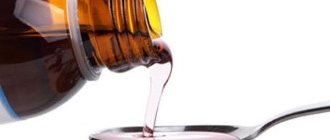Indications
Tetravit is used for the prevention and treatment of vitamin deficiencies; increasing endurance in stressful situations; when the need for vitamins increases due to additional stress: during pregnancy (only in the second half); during lactation, especially in cases of reproductive dysfunction; when moving animals; when changing the diet; with growth retardation and insufficient weight gain; for infectious and invasive diseases; during veterinary measures: preventive vaccinations and deworming; after surgery or injury; with poor egg production and reduced egg shell strength in chickens.
Analogs
Analogs of the drug include the following:
- Aminovit;
- Aminor;
- Biocefit;
- Vikasol;
- Gamavit;
- Gelabon;
- Dufalight;
- Immunophore;
- Introvit.
Products from animals containing the drug in their feed are suitable for consumption. When using the drug, personal hygiene must be observed; if Tetravit gets on vulnerable parts of the body, they must be rinsed with water.
The use of drug bottles for domestic purposes is prohibited.
Video: “Vitamins for animals”
Doses and method of administration
The drug is administered intramuscularly, subcutaneously or orally to animals in the following doses (per animal per day in ml): Cattle 5 – 6 Horses 3 – 5 Calves, foals 2 – 3 Sheep, goats 1 – 2 Lambs 1 Pigs 3 – 5 Weaned piglets 1 .5 Replacement young stock 2 Suckling piglets 1 Newborn piglets 0.5 Dogs 0.2 - 1 Rabbits 0.2
For prophylactic purposes, the drug is administered to animals once every 2–3 weeks, for therapeutic purposes – once every 7–10 days.
The drug is administered to pregnant sows 3–4 weeks before farrowing, and to cows 1–1.5 months before calving.
When administered orally, the drug is given to animals with food or drinking water for three weeks.
I. General information
1. Name of the medicinal product for veterinary use:
– trade name – Tetravit (complex of vitamins A, D₃, E, F in oil));
– international non-proprietary names of active ingredients – vitamin A, vitamin D₃, vitamin E, vitamin F.
2. Dosage form – solution for injection and oral use.
Tetravit (complex of vitamins A, D₃, E, F in oil) in 1 ml contains as active ingredients: vitamin A (retinol palmitate (acetate)) – 50,000 IU, vitamin D₃ (cholecalciferol) – 25,000 IU, vitamin E (tocopherol acetate ) – 20 mg, vitamin F – 5 mg, and as excipients: butylated hydroxytoluene, benzyl alcohol, fatty vegetable oils: sunflower, olive, almond.
3. In appearance, the drug is a transparent oily liquid from light yellow to yellow. Shelf life, subject to storage conditions in closed original packaging, is 2 years from the date of production, after opening the bottle - 28 days.
It is prohibited to use the medicinal product after the expiration date.
4. Tetravit (complex of vitamins A, D₃, E, F in oil) is produced packaged in 100 ml glass bottles of appropriate capacity, hermetically sealed with rubber stoppers, reinforced with aluminum caps with tamper evident clips. Each consumer package is supplied with instructions for use of the drug.
5. Store the medicinal product in the manufacturer’s sealed packaging, separate from food and feed, in a place protected from direct sunlight, at a temperature from 0°C to 25°C.
6. Tetravit (complex of vitamins A, D₃, E, F in oil) should be stored out of the reach of children.
7. Unused medicinal product is disposed of in accordance with legal requirements.
8. Tetravit (complex of vitamins A, D₃, E, F in oil) is available without a veterinarian's prescription.
Biological properties
Tetravit replenishes vitamin deficiencies in animals' bodies. Vitamin A regulates the structure, function and regeneration of epithelial tissues and thereby increases resistance to infection. Higher doses prevent weight loss and increase metabolism. Vitamin D3 regulates the metabolism of calcium and phosphorus and affects their absorption in the gastrointestinal tract, and has an antirachitic effect. Vitamin E regulates redox processes and affects carbohydrate-fat metabolism; enhances the effect of vitamins A and D3. Vitamin F regulates the metabolism of fatty acids and lipids; participates in the transformation of carotene into vitamin A, oxygen transport and cellular respiration; has a positive effect on the reproductive system, hair and skin.
The introduction of drugs into the body leads to an increase in vitamins in the blood and their accumulation in the liver and other tissues.
Side effects
When taking Tetravit there are no side effects with the exception of allergic reactions, which occur very rarely. If such reactions occur, consultation with a veterinarian is recommended.
Contraindications
Tetravit is contraindicated in case of hypersensitivity to individual components of the drug, allergic reactions, hypervitaminosis, or when taking retinoids.
Other contraindications:
- cholelithiasis;
- gallbladder disease;
- liver failure.
During pregnancy
The drug is not recommended for use during pregnancy; violation of this condition can provoke negative consequences affecting the development of the fetus.
Reviews
On the Internet in various forums you can find discussions of a variety of vitamin complexes; some users note the rather slow action of Tetravit.
Before giving Tetravit to an animal, you must consult a doctor..
In addition to the consultation, a medical examination is also provided, which identifies deficiencies of vitamins and microelements in the body.
Only this approach can provide the necessary support to the body when it is most needed.
Many Internet users note the high effectiveness of the drug in the fight against vitamin deficiency , we are talking about cats and dogs, as well as cattle, chickens, etc.
Owners note the ease of use of the drug, the improvement in the appearance and well-being of their pets.
Tetravit perfectly fights against vitamin deficiencies and hypovitaminosis, in cases of disturbances in the normal development of animals. This product is easily tolerated by animals , there are very few contraindications, and side effects are extremely rare.
After the course of treatment, the animals feel great, eat well, and their height and weight are normalized, despite the fact that there were problems with this previously.
Reviews about the drug can be read at the end of the article.
Diet for people with colostomy
Some foods may cause gas and discomfort. In this case, try not to consume them temporarily; later you can reintroduce them into your diet and observe the body’s reaction. You need to try introducing these foods into your diet at least three times, this is the only way you can make sure that this particular product really causes discomfort.
A balanced diet containing carbohydrates, proteins, fats, vitamins, minerals, and foods that replace the loss of potassium and sodium is important. Gradually increase your intake of plant fibers (1-2 months after surgery), which are difficult to digest.
Meals should be regular - at least 3 times a day. Don't forget about balanced fluid intake - 1500-2000 ml of fluid per day.
Gas formation
The natural process of gas formation occurs in the intestines. Gas is produced when carbohydrates (sugars, starches, fibers found in food) are digested in the colon. Between eating and the release of gas through the stoma, 5-6 hours usually pass. With an ileostomy, such gases are not produced because the colon is removed. However, air enters the body during eating, and gas can also form during eating, so you need to eat slowly and chew your food thoroughly. Try not to chew gum or drink through a straw.
Some foods cause increased gas formation, so in public places, pay attention to what products are used in the preparation of dishes. Also consider using a colostomy bag with a filter, which removes excess air from the bag without allowing the bag to bloat and neutralizes odor. In addition, you can use some medications that reduce gas formation. To do this, consult a specialist.
Remember that the same foods contribute to excessive gas formation in some people, but not in others.
Products that promote gas formation:
- White cabbage, Brussels sprouts, cauliflower, broccoli
- Spinach
- cucumbers
- Beans
- Peas
- Onion garlic
- Corn
- Carbonated drinks/beer
- Products that reduce gas formation:
- Peppermint oil
- Tea with mint
- Activated carbon
Sounds (rumbling) from the stoma
To muffle the rumbling from the stoma, place your hands on the colostomy bag (on the stoma).
Smell
If you change your colostomy bags regularly, if your colostomy bag doesn't leak, no one will notice the smell. You may only smell it when you change your colostomy bag.
To combat the unpleasant odor that accompanies the release of gas, use colostomy bags with a carbon filter.
If you are using a draining colostomy bag without a filter, you can use an odor neutralizer. Place 5-6 drops into the bag after draining or into a new bag after replacing (read the instructions for using the neutralizer).
Products that increase the release of unpleasant odors during digestion:
- Fish
- Eggs
- Cheese
- Garlic, onion
- Beans
- Cabbage
- Products that reduce the release of unpleasant odors:
- Yogurt
- Cottage cheese
- Kefir, fermented baked milk
- Cowberry
- Spinach
- Green salad
- Parsley
Constipation
Constipation is a delay in the passage of intestinal contents through a stoma. To avoid it, eat more foods containing plant fiber: fruits, vegetables and cereals, as well as at least 6-8 glasses of liquid per day. Sometimes, with prolonged constipation, you should resort to laxatives, but be sure to consult your doctor before doing so.
Products that have a laxative effect:
- Raw vegetables and fruits
- Prunes, figs, plums
- Beans
- Fresh juices
- Dairy products
- Products with a fixing effect:
- Potato
- Bakery products
- Pasta
- Rice
- Baked apples
- Pears
- Cheese
Interactions with other drugs, side effects and analogues of Tetravit
While taking Tetravit, you should take calcium, phosphorus, magnesium, and protein. The drug should not be taken with any laxative or aspirin, as its effect is reduced. Does not combine well with other vitamin complexes.
side effects were found for the drug . If you follow the instructions, taking the vitamin complex will only bring positive effects to the animal. It should be remembered that cats, dogs and other pets need to administer Tetravit only subcutaneously. Otherwise, the animal will develop a rash.
If the animal has an individual intolerance to any components of the drug, then its administration should be discontinued. In case of hypervitaminosis, taking the drug is strictly prohibited.
Analogues of Tetravit include:
- Aminovit;
- Aminor;
- Gamavit;
- Immunorf;
- Dufalight;
- Introvit;
- Trivit.
Tetravit can be prescribed for stomach ulcers and liver dystrophy.
If the medicine gets into your eyes, rinse them thoroughly. If the solution gets on the skin, rinse with running water and detergent. If an allergic reaction occurs, you should immediately go to a medical facility, taking instructions with you. to the drug, where its active components are indicated.

